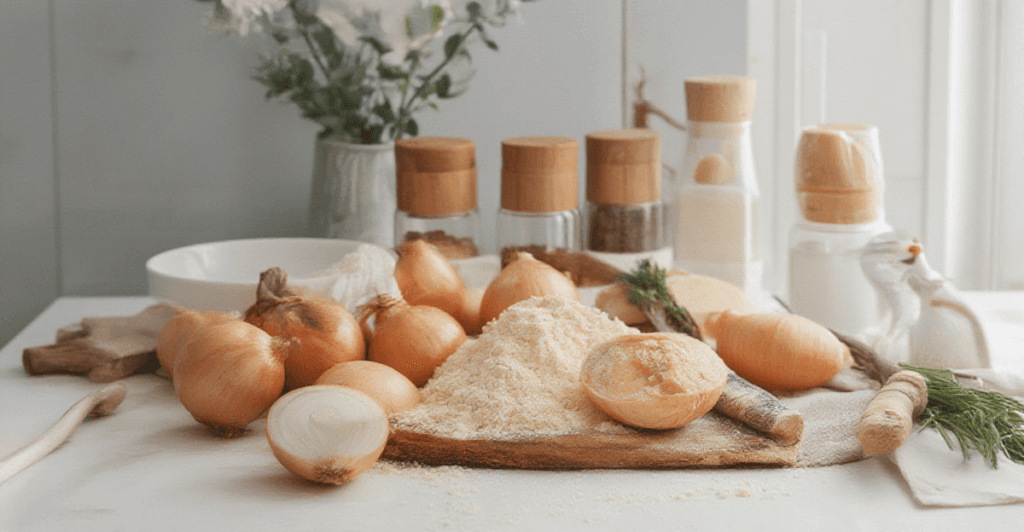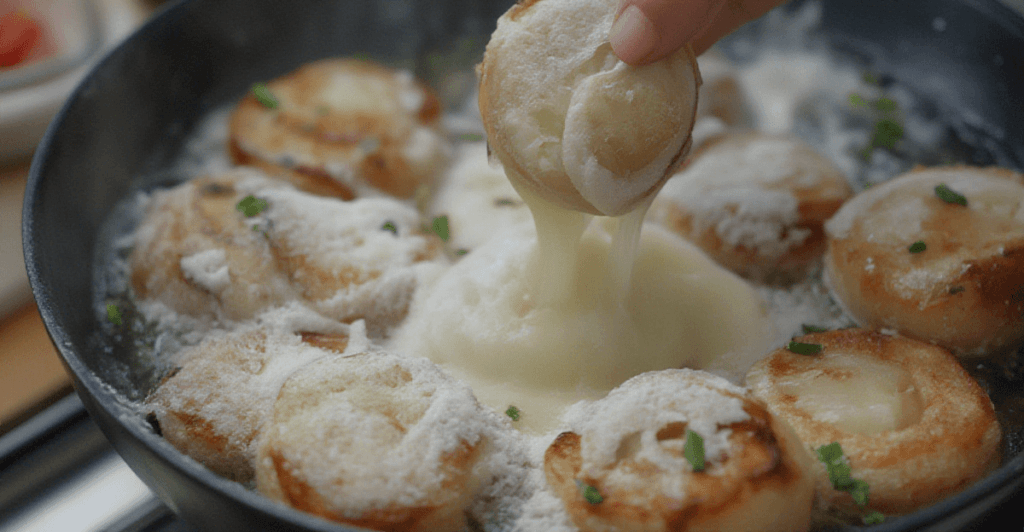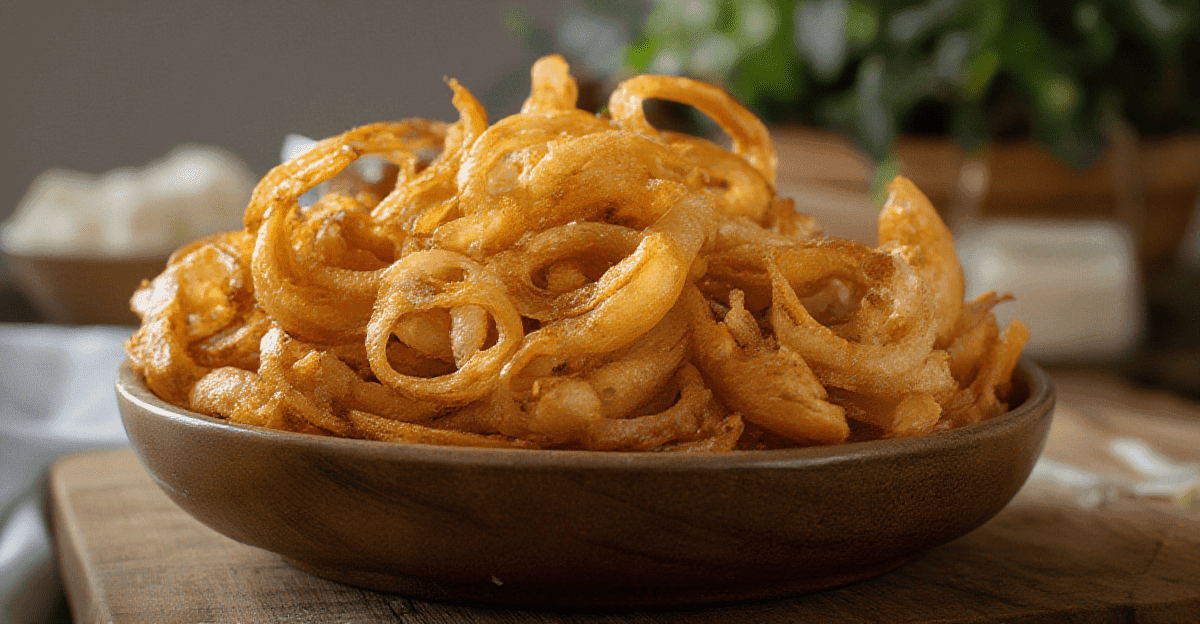French fried onions are a versatile and delicious topping commonly found in casseroles, salads, soups, and burgers. Their crispy texture and savory flavor make them a pantry staple for many households. But what exactly are they made of? In this article, we’ll explore the core ingredients, how they are made, and their popular culinary uses.
Introduction
French fried onions are thinly sliced onions coated in a seasoned batter and deep-fried to golden perfection. They’re celebrated for their crunchy texture and bold flavor, which comes from a combination of carefully chosen ingredients. Whether you enjoy them as a topping or a snack, French fried onions offer a delightful addition to a variety of dishes.
The Core Ingredients

French fried onions are made from a handful of basic ingredients that work together to create their crispy and flavorful appeal. Let’s break them down:
Main Ingredient: Onions
The star of the show is, of course, onions! Usually, yellow or sweet onions are used because they have a naturally mild and slightly sweet flavor. These onions are thinly sliced to ensure they fry evenly and become crispy during the cooking process.
The slicing is an important step because thinner slices allow for a lighter and crispier texture. This is what gives French fried onions their signature crunch when you bite into them.
Batter Composition: Flour and Seasonings
After slicing, the onions are coated in a batter made from all-purpose flour. The flour serves as the base of the batter, creating the crispy outer layer when fried. To enhance the flavor, the batter is mixed with seasonings like:
- Salt
- Pepper
- Garlic powder
- Sometimes paprika or cayenne for a little kick
The seasoning combination can vary depending on whether the onions are made at home or mass-produced by companies. These spices are what give French fried onions their savory, slightly spicy taste that pairs well with many dishes.
Oil for Frying: The Key Component
The next essential ingredient is oil. French fried onions are typically deep-fried in vegetable oils such as canola, sunflower, or soybean oil. These oils are chosen because they can handle high heat and don’t interfere with the onion’s flavor.
Deep-frying creates the golden-brown crust and that irresistible crispiness French fried onions are known for. The type of oil used can slightly affect the taste, but most oils are neutral to ensure the onion flavor shines through.
Optional Additives and Preservatives
For store-bought French fried onions, there may be a few extra ingredients added to improve their shelf life or texture. These might include:
- Preservatives like citric acid to keep them fresh
- Cornstarch for added crunch
- Sugar for a touch of sweetness in the batter
These additives help store-bought varieties stay crispy and flavorful for longer, making them convenient to use straight from the can.
In short, French fried onions are made from simple, everyday ingredients: fresh onions, a seasoned flour batter, and oil for frying. Optional additives may be used for packaged versions to ensure they stay fresh and crispy. In the next section, we’ll look at how these ingredients come together during the cooking process to create this beloved snack and topping.
How French Fried Onions Are Made

Now that we’ve talked about what French fried onions are made of, let’s explore how they’re made. The process involves several steps, all designed to create that perfect crispy texture and delicious flavor. From preparing the onions to frying them, each step plays an important role.
Preparation of Onions: Slicing and Soaking
The first step in making French fried onions is preparing the onions themselves. Fresh onions are peeled and then sliced into thin, even rings. Thin slices are essential because they help the onions fry evenly and become super crispy.
Once sliced, the onion rings are often soaked in cold water. This step helps reduce the sharpness of the onions and ensures they cook up light and crispy instead of becoming soggy. After soaking, the onions are dried thoroughly, so the batter sticks better during the coating process.
The Coating Process: Batter and Breading
After preparation, the onions are coated in a seasoned batter. The batter, as we mentioned earlier, is made from flour and seasonings like salt, pepper, garlic powder, and sometimes paprika.
Here’s how it works:
- The onion slices are dipped into the wet batter, ensuring every piece is coated evenly.
- Next, the coated onions might be rolled in a layer of breadcrumbs or a flour mixture. This extra step adds even more crunch when the onions are fried.
The coating process is important because it gives Crispy rings their signature golden-brown crust and bold flavor.
Deep-Frying: Achieving the Crisp Texture
Once coated, the onion slices are ready to be fried. Deep-frying is the key to making French fried onions as crispy and flavorful as possible.
Here’s what happens during frying:
- The battered onion rings are dropped into hot oil heated to around 350–375°F (175–190°C).
- The onions cook quickly, usually in just a few minutes, turning a beautiful golden-brown color.
- After frying, the onions are removed from the oil and placed on paper towels or a wire rack to drain excess oil.
Deep-frying locks in the flavor and creates the crunchy texture that makes French fried onions so irresistible. The high heat also caramelizes the natural sugars in the onions, giving them a slightly sweet taste.
Optional Final Steps: Packaging or Storage
For store-bought French fried onions, there are a few extra steps. After frying, the onions are cooled and packed in airtight containers to keep them fresh. Preservatives like citric acid may be added to extend their shelf life.
For homemade French fried onions, you can store them in an airtight container or enjoy them fresh for maximum crispiness.
Now you know how simple ingredients like onions, batter, and oil come together through slicing, coating, and frying to make French fried onions. In the next section, we’ll explore their nutritional value and discuss whether they’re a healthy addition to your meals.
Nutritional Composition
French fried onions are delicious and crispy, but you might wonder about their nutritional value. Let’s break down their calories, nutrients, and whether they fit into a healthy diet. Understanding what they contain can help you decide how to enjoy them in moderation.
Calories and Macronutrient Breakdown
French fried onions are a high-calorie food because they’re fried in oil and coated with batter. A small serving, about 1/4 cup (30 grams), contains approximately:
- Calories: 140–150
- Fat: 10 grams
- Carbohydrates: 10 grams
- Protein: 1–2 grams
The majority of the calories come from the oil used for frying and the flour in the batter. While they don’t have much protein, they’re a rich source of energy thanks to their fat and carbohydrate content.
Sodium Content and Additives
One thing to keep an eye on is the sodium content. French fried onions are usually seasoned with salt, and store-bought versions may include additional preservatives that increase the sodium levels. A typical serving contains around 150–200 milligrams of sodium, which is about 8–10% of your daily recommended intake.
For individuals watching their sodium intake, it’s a good idea to enjoy French fried onions in moderation. If you’re making them at home, you can control the amount of salt and skip preservatives altogether.
Are French Fried Onions Healthy?
French fried onions are undeniably tasty, but they’re not considered a health food. Because they’re deep-fried, they’re high in fat and calories. The type of oil used can also impact their healthiness. For example:
- Vegetable oils like canola or sunflower oil are commonly used, but they’re still calorie-dense.
- Reusing oil for multiple frying sessions, as is common in large-scale production, can increase unhealthy fats.
That said, French fried onions can be part of a balanced diet when eaten in small amounts. They’re more of a treat or topping than a main food item. To enjoy them without guilt, try adding a small amount to a healthy dish like a salad or roasted vegetables.
French fried onions are rich in flavor and calories, making them best suited as an occasional indulgence or garnish. In the next section, we’ll explore their many uses in cooking and how they can add flavor to everyday meals.
Common Uses in Cooking
French fried onions are more than just a crispy snack. Their crunchy texture and savory flavor make them a favorite ingredient in many recipes. Let’s explore how they’re used in different dishes to enhance both taste and presentation.
Topping for Casseroles
One of the most popular uses for French fried onions is as a topping for casseroles. A classic example is the green bean casserole, a dish often served during holidays like Thanksgiving.
French fried onions are sprinkled on top of the casserole before it’s baked. During baking, the onions stay crispy while adding a rich, savory flavor that balances out the creamy sauce and tender vegetables.
If you’re making a casserole at home, French fried onions are an easy way to add crunch and take the dish to the next level.
Salad Enhancer
Salads can sometimes lack texture, but adding French fried onions solves that problem! These crispy onions make an excellent topping for green salads, potato salads, and even pasta salads.
They provide:
- A satisfying crunch that pairs well with leafy greens or creamy dressings.
- A boost of flavor without needing extra seasoning.
Simply sprinkle a handful of Crispy rings over your salad just before serving for the best texture and taste.
Crispy Garnish for Soups and Burgers
French fried onions are also widely used as a garnish. For example:
- In soups, they add a burst of flavor and texture. Creamy soups like mushroom, tomato, or butternut squash are especially good with a handful of crispy onions on top.
- On burgers, French fried onions bring an extra crunch. They’re a great alternative to raw onions, offering a milder and sweeter flavor.
You can even use them to top baked potatoes, tacos, or sandwiches for a quick upgrade in taste and presentation.
Creative Recipes Featuring French Fried Onions
French fried onions aren’t just for traditional dishes—they’re also used in creative recipes. Here are a few ideas:
- French Fried Onion Crusted Chicken: Use them as a coating for baked or fried chicken to give it a flavorful, crispy crust.
- Savory Onion Bread: Mix Crispy rings into bread dough for a unique twist.
- Stuffed Mushrooms: Add them as a crunchy topping for stuffed mushrooms filled with cheese or meat.
With a little creativity, Crispy rings can turn everyday recipes into something special.
FAQs
What Are Onion Fries Called?
Onion fries are often referred to as French fried onions or simply fried onions. These are thinly sliced onions coated in batter and deep-fried until crispy. Depending on their preparation, they may also be called:
- Crispy onions (commonly used as a topping).
- Onion straws or onion strings (when cut into long, thin strips).
- Onion rings (when the onions are cut into circular slices and fried).
No matter the name, these variations are popular for their crunchy texture and savory flavor.
What Is the Secret Ingredient in McDonald’s French Fries?
McDonald’s French fries are famous for their unique taste, and the “secret ingredient” behind that flavor is natural beef flavoring. While the fries are made primarily from potatoes, the beef flavoring is added to the oil used during the initial frying process to enhance their signature taste.
Here’s what gives McDonald’s fries their distinct flavor:
- The beef flavoring contains wheat and milk derivatives, which provide a savory umami taste.
- They also use a small amount of dextrose (a type of sugar) to give the fries a golden color when cooked.
- Additionally, citric acid is added as a preservative to keep the oil fresh.
This combination of ingredients makes McDonald’s fries stand out from others, but it also means they’re not vegetarian in some regions.
Why Do You Soak French Fries in Water Before Frying?
Soaking French fries in water before frying is a crucial step for achieving the perfect texture. Here’s why:
- Removes Excess Starch: Potatoes naturally contain starch, which can make fries stick together and turn soggy. Soaking removes some of the starch, ensuring fries stay crispy on the outside.
- Prevents Browning: Starch on the surface of the potatoes can cause uneven browning. Rinsing it off helps fries cook evenly and get that golden-brown color.
- Improves Crispiness: Soaking the fries in cold water firms up the potato slices, resulting in a better texture when fried.
For best results, soak the potato slices in cold water for at least 30 minutes before frying. Some chefs even recommend soaking them overnight in the fridge for an extra-crispy finish.
Conclusion
French fried onions are a simple yet delicious ingredient made from fresh onions, flour-based batter, and oil. These crispy delights are loved for their savory flavor and crunchy texture, which make them a perfect topping or garnish for many dishes.
Whether you buy them from the store or make them at home, French fried onions can elevate your casseroles, salads, soups, and even burgers. They’re easy to use, versatile, and bring both flavor and texture to your meals.
While they are high in calories and sodium, they can be enjoyed in moderation as part of a balanced diet. Plus, making them at home gives you control over the ingredients and lets you customize the flavor to suit your preferences.
From topping classic green bean casseroles to being used as a creative ingredient in recipes like onion-crusted chicken, the possibilities with French fried onions are endless. Whether you’re cooking for a special occasion or just adding crunch to a simple dish, French fried onions are always a great choice.
So, the next time you reach for a can of French fried onions or decide to make them yourself, you’ll know exactly what goes into them and how they’re made!

